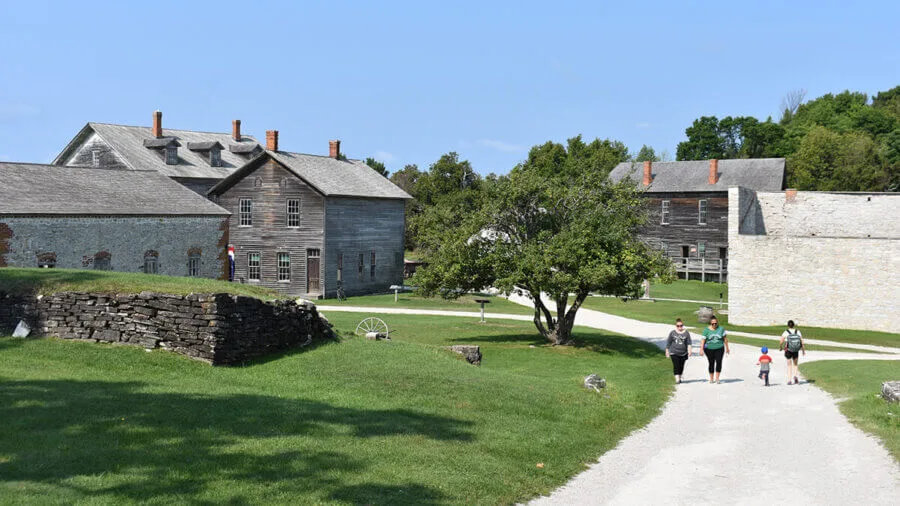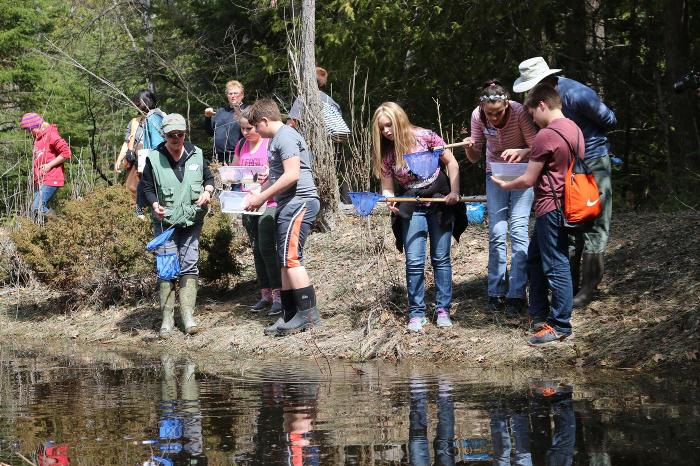
Fayette Historic State Park and Harbor (photo via Michigan Economic Development Corp.)
These are eerie snapshots of our state’s past.
MICHIGAN—There’s certainly something spooky about a local community that’s been abandoned, and Michigan has its fair share of them. But ghost towns also offer a rare glimpse into the past—a snapshot of our state’s story that we may never get back.
From one village that’s now buried under a body of water, to another literally wiped away by sand—here are six ghost towns in Michigan you should definitely spend some time exploring.
Old Rawsonville Village (Wayne County)

Rawsonville was once a thriving community near Belleville. As reported by MLive, the village was home to several economy-driving businesses, including a saw mill and a wagon maker. But Rawsonville began to struggle after the Civil War because it was not able to attract railroad service, and people moved on to find work. In 1925, a dam was built on the Huron River, creating the newly formed Belleville Lake, covering the remains of the village. All that remains now is a historical marker.
Pere Cheney (Crawford County)

With an infectious disease wiping out much of the population and devastating fires caused by sparks from the mills nearby, it’s no wonder Pere Cheney no longer exists.
As Click On Detroit reports, the town, located a short drive away from Grayling, was abandoned in 1917 after being hit with back-to-back epidemics of diphtheria. All that remains is the cemetery, which is rumored to be haunted. Legend has it that the spirit of an unwed mother accused of being a witch cursed the village with the plague that decimated .
“If you plan on visiting Pere Cheney, have some respect and don’t go in there expecting to see a ghost,” ” one former local wrote. “Just enjoy the natural beauty of the Northern Michigan countryside and make sure you pick up your garbage.”
Fayette Historic Park and Townsite (Delta County)

Fayette was a bustling, iron-smelting town back in the mid 1800s, where over 500 people once called home. The Jackson Iron Company created a blast furnace that turned iron into pig iron, which contributed to this town being considered “one of the best places to buy pig iron for the Great Lakes steel mills,” according to Up Travel.
But in 1891, the company went under and turned Fayette into a ghost town.
Standing eerily empty now are more than 20 original historical preserved buildings by the Michigan Department of Natural Resources. There is a peaceful solitude that falls over Fayette. Visitors can also take self-guided tours of this ghost town while enjoying the view of ancient cedar trees located across the harbor.
Singapore (Allegan County)

Singapore was going to be the next big city in the Midwest. At its peak in the mid 1800s, as many as 300 people called the town at Lake Michigan on the Kalamazoo River home, the Chicago Tribune reports.
But Mother Nature had other plans when trees in the surrounding area were cut down to support rebuilding efforts in Chicago and Holland, which has been destroyed by fires. Without the protection of tree cover, the town of Singapore was exposed to onshore winds and sands coming off Lake Michigan. Within just four years, the town was completely eroded.
“The town was gone, so there was nothing left to save,” a researcher told the Tribune. “There was nothing to stop the blowing sand. The natural resources were depleted and that is what caused the whole town being buried by the sand dune.”
Port Crescent (Huron County)
In the late 1860s, Port Crescent was once the largest booming lumber town in Saginaw Bay. Eventually, however, the lumber business fizzled out after fires destroyed acres of timber, and the town was abandoned. Today, the area is home to Port Crescent State Park.
The only reminders of the community of Port Crescent left behind are the original smokestack and the Port Crescent Cemetery.
“It’s the graves themselves that send shivers down the backs of those who enter. If you go back there at night time, it’s extra-eerie,” states a 99wfmk.com article. “These are old 1800s tombstones of the original Port Crescent residents. The town is long gone, but the ‘people’ are still there.”
Nonesuch Mine (Ontonagon County)
In 1865, this town was once a short-lived home to a bustling copper mine city located in Michigan Copper Country; it was named for a type of fine copper discovered in sandstone. Once the mining ended, the people moved on.
While the town itself no longer exists, there are visible ruins located throughout the woods in Porcupine Mountains. Nonesuch Mine is littered with historical signage of what happened once upon a time here in this town.
Politics

Whitmer expands clean water plan while enviros call for more clean energy investments
BY KYLE DAVIDSON, MICHIGAN ADVANCE MICHIGAN—As construction workers at the Delta Township Wastewater recovery facility continued efforts to expand...

Michigan Dems push for action on prescription drug board bills
BY KYLE DAVIDSON, MICHIGAN ADVANCE MICHIGAN—Four Democratic House members are renewing the call for action on prescription drug affordability,...

Local election workers fear threats to their safety as November nears. One group is trying to help.
TRAVERSE CITY—The group gathered inside the conference room, mostly women, fell silent as the audio recording began to play. The male voice, clearly...
Local News

These students are protecting the ‘coral reefs’ of Michigan—and you can too
Vernal pools are a critical part of Michigan’s natural ecosystem—but they’re not protected by state regulations. Here’s how Michiganders are...

The food at Comerica Park puts peanuts & Cracker Jacks to shame
Gone are the days when peanuts and Cracker Jacks were the most exciting food items at baseball games. Baseball stadiums around the country now boast...





